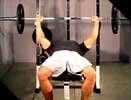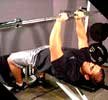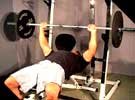1. Shoulders Back:
When bench pressing your shoulder girdle should be kept in a RETRACTED position. This may take practice at first if your not used to it. Stand normal with your hands against the wall. Now take one step backwards. From here, without bending at the hip or leaning forward, stretch your arms out as far in front of you to try to touch the wall.
That is the PROTRACTED position. To get to the retracted position, you have to do the opposite and pull your arms as far back as possible at the shoulder girdle (no bending of the elbows). In a sense you are squeezing your shoulder blades together. Practice for 5 minutes a day for a few days or a week and you'll have it down in no time. This is the position your shoulders should be in for the safest and most powerful bench press.
2. Use Your Feet:
Make sure your feet are planted FIRMLY on the floor and do not come up during your bench attempts. They should also not be moving around. This creates a stable base and foundation, which makes your bench more powerful. The whole body must be stable during a bench press and the feet are a huge part of that.
In addition, when benching you can learn to kind of "push" off with your feet for additional power. Try this during your normal chest workouts until you can get it down, then use it to help increase your max on bench!
3. Visualize:
Before every single max attempt you need to visualize yourself doing that weight. This also may take a little practice but you should be able to see yourself benching that weight. You should be able to "feel" the heaviness of the bar on you and the strain in your arms and chest as you move the weight. "Feel" the bar in your hands; "hear" the sounds of the gym. Literally go through the motions without the weight while you do this. This will help prepare your body for what is to come so that it won't be such a huge shock.
4. Lie To Yourself:
This technique works well for some people if they can be really convincing and are good at lying to themselves and making themselves believe it. Before you attempt a max bench press, lie to yourself about the weight.
Say you have 200 pounds that you are about to try to bench. Lie to yourself and tell yourself that it is nothing and that you've done it before. Also, pretend that it is only 150 pounds for example. This may help you get that weight up!
5. Squeeze Your Glutes:
For the average lifter this technique is one that is never thought of or heard about. Your body is only as strong as it's weakest link. By tightening up your glutes as you perform the bench, you will help reinforce that stability that the body needs so that you can channel power from your whole body into the bench. You will be amazed at how well this can work.
6. Find The Right Grip:
Depending on your strengths and weaknesses you may want to try different grips on your bench press. For example, if your triceps tend to be a little bit stronger, take your grip a little bit narrower. If they tend to be a little weaker, try widening your grip slightly.
However, you need to remember that any time you change your grip it may feel a little different and uncomfortable at first. Your body adapts to the new grip quickly and if you really had business changing your grip, you will notice your bench going up.
7. Work On Weak Areas*:
*(top portion, bottom portion)
If you have a particular weak area of the bench, for example getting stuck at the bottom or getting stuck halfway up, you may want to work on JUST that section of your bench press. Also remember, your shoulders are a lot more "in play" at the bottom of the movement and your triceps are a lot more "in play" at the top of the movement. No matter where you are getting stuck, start benching inside a power rack and set it up so that you are benching using only a range of motion within your weak zone.
8. Use A Thicker Bar:
Using a thicker bar temporarily can help make your benching seem easier when you switch back to a standard sized Olympic bar. Many power lifters use this technique. Chances are if you go to a fitness center rather than an all out gym, you may have a hard time finding this thicker bar.
9. Move Past Mental Barriers:
We all know how mental working out can be and this is especially true with the bench press. A person could use the same weight on an exercise for years and never go up just because that is what they're "used to". Once they convince themselves that they can do more and that it's time to try they often surprise themselves. Is your unyielding bench a result of a physical plateau or a mental plateau? That is what you need to ask yourself and be honest with.
10. Make Sure You're Properly Warmed Up:
Jumping into an attempted one rep max on bench press is probably the most costly mistake as far as missing your goals on bench press. When you max out, your muscles need to be thoroughly warmed up but not excessively warmed up. In other words you don't want your muscles to be tired when you start your maxing session but you also need to make sure they are adequately warmed up. This will help prevent devastating injuries as well.
11. Pyramid Up:
It is wrong to attempt a max at the highest weight you are looking get up. This sounds obvious but many people make this mistake. Let's say you want to max out on 450 pounds for one rep. To start out at 450 pounds is foolish. Instead, you should start with a warm-up weight and then pyramid up in large increments.
For example, you might do 225 for 6 (obviously not to failure but just to prepare the muscles) then go to 300 for 5 (not to failure), then 360 for 2 (not to failure but heavy), then to 420 for one, then try going for 450. You need to pyramid the weight up and not go for it all at once.
12. Take 3-5 Minutes Between Heavy Sets:
Any good power lifter knows this to be true. When you "max out," you are using a different energy system in the body than when you are performing a bodybuilder's routine. For that system to fully recover between heavy sets so that you can move the most weigh the next set you need to rest between three and five minutes.
13. Keep Warm:
This tip goes right along with number twelve. Since you need to take the extra time to rest between your heavy maxing sets you need to make sure that your body does not cool down. You should stay warm throughout the session. During this time do not let your body get cold. Wear hooded sweatshirts and sweatpants; wrap towels around your legs, whatever you have to do to stay warm.
14. See The Top:
It is always helpful to visualize yourself pushing the bar right through the top of the movement. Never get caught up in the moment during the bench or think about the position that the bar is at. What you need to do is "see" the top. Don't let the bar stop moving until it reaches the top. If you have ever raced or are a runner you know that you don't slow down as you approach the finish line.
While this is evident, it sometimes helps to use this analogy when bench pressing. Nobody is going to consciously slow down the bar or use less effort as the bar moves up but the mind works on subconscious levels as well. For this reason you need to visualize yourself blasting right through the top of the movement.
15. Chest Up:
This works on two levels. First, by keeping your chest up you put yourself in a more advantageous position. What's more important, and you see power lifters doing this all the time in meets (the Chinese are great at it), is that by increasing the height of your chest you decrease the distance the bar must travel in turn decreasing the amount of force that is needed to move the same amount of weight.
16. Keep Glutes Down On Bench:
I'm not completely sure what people are thinking when they lift their glutes off the bench. Some people think that pushing with their feet means their glutes need to come up off the bench. This is not only dangerous but it weakens your bench.
17. Deep Breath Before Lowering Bar:
Before lowering the bar take a deep breath and hold it. What this does is creates a more solid torso from which you can generate power. It stabilizes the muscles of the thorax and helps keep the body in a more beneficial state for increasing your bench.
18. Use Your Lats:
This technique is way underused and overlooked. The lats play a big part in a strong bench press. By increasing the strength of your lats you can actually add to your bench press. Also by squeezing the lats out and "pushing" with them you will be able to move more weight. Your lats should be flexed throughout the entire movement.
19. Train Helper Muscles:
Don't neglect the other muscles besides the chest that are used in the bench press. Remember, a chain is only as strong as it's weakest link. If your shoulders are lagging in strength compared to your chest, triceps, and other body parts, you need to work to bring up the strength of that muscle. Once you do that, your bench press will start to increase like crazy.
20. Avoid Over Training:
The existence of over-training is a very controversial matter. Over-training existing, it can destroy any gains in your bench press. Of course, you can help combat the over-training with eating more, and better foods and getting more rest between workouts.
Thanks,



